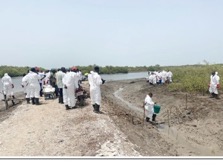
It could be recalled that on 28th May 2022, a vessel MT ST Stura discharged Heavy Fuel Oil at The Gambia Petroleum depot in Mandinary. The regulatory agencies immediately formed an Emergency Response Taskforce to manage and contain the oil spill.
Surveillance of the coastline was immediately launched last Sunday morning from Denton Bridge, Jeshwang, and then all the way to Mandinary depot with the help of speed boats that were used in a joint efforts to track and identify the affected coastline.
As part of the investigation in Banjul, Tourist boat owners confirmed sight of a large oil slick drifting out of the estuary into the sea and stains were confirmed on some of the boats.
Elsewhere, patches of oil were discovered in Pirang and Bonto, all in the West Coast Region in isolated amounts and the surveillance is ongoing and would continue as the investigation continues.
Divers are also being commissioned for underwater surveys to verify the deposit of oil on the riverbed.
During a visit to the scene on the banks of Kunkujang, Lamin Komma, programme manager and Head of Coastal and Marine Environment at the National Environmental Agency, said the oil spill has affected many areas much more than the mangroves where the oysters are.
“Scientifically, there will be an impact on them because that’s where they get their oysters for daily consumption, fish, and fishery products. Oysters are filter feeders because they get water into their system and then flush it and get the nutrient out of it.”
He said the move would result in drop in production of oysters due to the oil spill as well as affect mangrove in the affected areas.
Among other agencies are the Public Utility and Regulatory Authority, Gambia Maritime Administration, Gambia Ports Authority, and Gam Petroleum.





